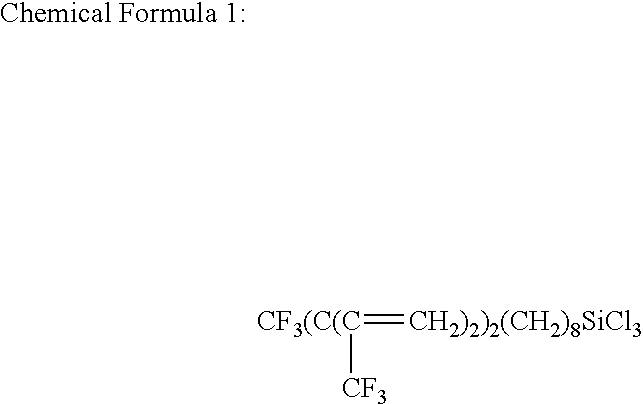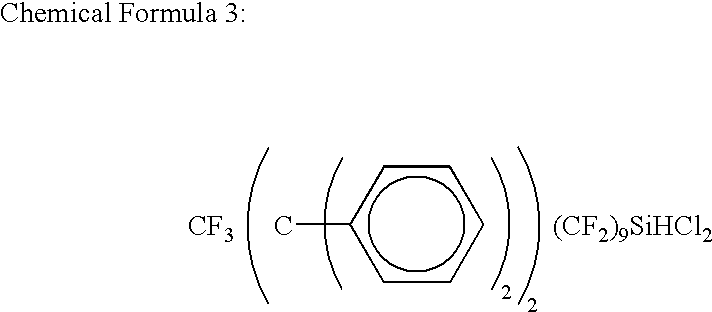Mold, method for fabricating mold and pattern formation method
- Summary
- Abstract
- Description
- Claims
- Application Information
AI Technical Summary
Benefits of technology
Problems solved by technology
Method used
Image
Examples
embodiment 1
[0068] Embodiment 1
[0069] Embodiment 1 of the invention will now be described with reference to FIGS. 1A through 1C and 2A through 2C.
[0070] First, as shown in FIG. 1A, a reverse pattern 11 corresponding to a mirror image of a pattern to be transferred (for example, an interconnect pattern), which is obtained by reversing the pattern to be transferred, is formed from a silicon oxide film on a mold substrate 10. Thus, a mold body composed of the mold substrate 10 and the reverse pattern 11 can be obtained. The reverse pattern 11 may be formed from a silicon film or a silicon carbide film instead of the silicon oxide film.
[0071] Next, the mold is immersed in a 0.2 wt % CF.sub.3(CF.sub.2).sub.7(C- H.sub.2).sub.2SiCl.sub.3 solution (solvent: a mixture of hexadecane and chloroform in a weight ratio of 4:1) for 10 minutes in a dry atmosphere (including substantially no moisture), such as an atmosphere with a water vapor concentration of 0.006 kg / m.sup.3. Thus, a surface treated layer 12 i...
embodiment 2
[0078] Embodiment 2
[0079] Embodiment 2 of the invention will now be described with reference to FIGS. 3A through 3D.
[0080] First, as shown in FIG. 3A, a reverse pattern 21 corresponding to a mirror image of a pattern to be transferred (for example, a contact hole), which is obtained by reversing the pattern to be transferred, is formed from a silicon oxide film on a mold substrate 20. Thus, a mold body composed of the mold substrate 20 and the reverse pattern 21 is obtained. The reverse pattern 21 may be formed from a silicon film or a silicon carbide film instead of the silicon oxide film.
[0081] Next, the mold body composed of the mold substrate 20 and the reverse pattern 21 is immersed in a 0.3 wt % CF.sub.3(CH.sub.2).sub.9Si(C- H.sub.3)Cl.sub.2 solution (solvent: a mixture of hexadecane and chloroform in a weight ratio of 4:1) for 10 minutes in a dry atmosphere (including substantially no moisture), such as an atmosphere with a water vapor concentration of 0.005 kg / m.sup.3. Thus,...
embodiment 3
[0085] Embodiment 3
[0086] Embodiment 3 of the invention will now be described with reference to FIGS. 4A through 4D and 5A through 5C.
[0087] First, as shown in FIG. 4A, a reverse pattern 31 corresponding to a mirror image of a pattern to be transferred (for example, an interconnect groove), which is obtained by reversing the pattern to be transferred, is formed from a silicon oxide film on a mold substrate 30. Thus, a mold body composed of the mold substrate 30 and the reverse pattern 31 is obtained. The reverse pattern 31 may be formed from a silicon film or a silicon carbide film instead of the silicon oxide film.
[0088] Next, the mold body composed of the mold substrate 30 and the reverse pattern 31 is immersed in a 0.2 wt % CF.sub.3(CF.sub.2).sub.8SiCl- .sub.3 solution (solvent: a mixture of hexadecane and chloroform in a weight ratio of 4:1) for 5 minutes in a dry atmosphere (including substantially no moisture), such as an atmosphere with a water vapor concentration of 0.006 kg...
PUM
| Property | Measurement | Unit |
|---|---|---|
| Weight per unit length | aaaaa | aaaaa |
| Concentration | aaaaa | aaaaa |
Abstract
Description
Claims
Application Information
 Login to View More
Login to View More - R&D
- Intellectual Property
- Life Sciences
- Materials
- Tech Scout
- Unparalleled Data Quality
- Higher Quality Content
- 60% Fewer Hallucinations
Browse by: Latest US Patents, China's latest patents, Technical Efficacy Thesaurus, Application Domain, Technology Topic, Popular Technical Reports.
© 2025 PatSnap. All rights reserved.Legal|Privacy policy|Modern Slavery Act Transparency Statement|Sitemap|About US| Contact US: help@patsnap.com



